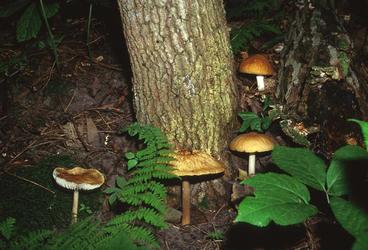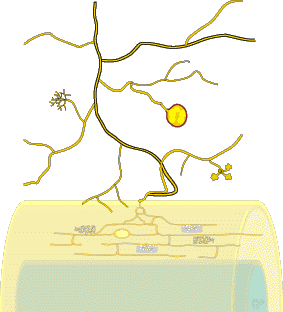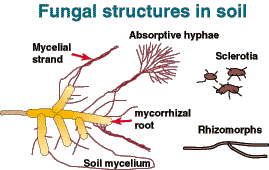Forest Fungi…one of the best kept secrets?

When people think of forest fungi, they probably envision mushrooms. However, mushrooms, which are the above ground fruiting bodies of some kinds of fungi, represent only a tiny fraction of the fungal diversity in a forest. The vast majority of forest plants form symbiotic relationships with mycorrhizal fungi where the plant gives the fungi carbon compounds produced from photosynthesis (food) and the fungi play a major role in the acquisition of water and nutrients for the plants (especially phosphorous and nitrogen). Mycorrhizal fungi are by far more abundant and diverse than the better known saprophytic fungi which are important in the process of decaying organic material, and our forests would not be the same without them!
First described in the mid-1800’s, the idea that fungi and plants formed a mutualistic symbiotic relationship was outrageous. Since then, we have come to know that not only do these relationships exist, but they are so widespread that they are considered the normal state for most plants under most ecological conditions and may have contributed to the successful colonization of land by plants millions of years ago.
Mycorrhizal fungi come in two general types, ectomycorrhizal and endomycorrhizal.
Ectomycorrhizal fungi form a white sheath (mantle) around the outer surface of plant roots, an inward growing network of fungal hyphae (hair-like strands) penetrating the plant root cells (called a Hartig net), and an outward growing system of hyphae that connect with the soil resources and the fruiting bodies of the fungi. Some types of ectomycorrhizal fungi form above ground fruiting bodies (mushrooms), while others do not. Only about 3% of seed plants are ectomycorrhizal, but they play a big role in our forests since they include most conifer species such as Pine, Cedar, and Spruce trees.
Endomycorrhizal fungi, more commonly referred to as vesicular arbuscular mycorrhizal fungi (VAM) or simply arbuscular mycorrhizal fungi (AM), are by far the most common underground symbionts* and probably originated on earth 350-460 million years ago.
*The word “symbionts” indicates that the two organisms have a 2-way, mutually beneficial relationship. We don’t call them “hosts” because that word usually indicates that one organism is parasitizing another.

|

|
VAM fungi do not form the white mantle around roots as do the ectomycorrhizal fungi, nor do they form above ground fruiting bodies. Instead, they form complex fungal structures within the plant root cells and an extensive network of fungal structures in the soil called the mycelium. Because VAM fungi don’t form large structures like mantles and fruiting bodies, they are much more difficult it identify and study than ectomycorrhizal fungi. However, in recent decades new techniques have allowed researchers to discover how important VAM fungi really are. Most (80% or more) plants form some kind of relationship with endomycorrhizal fungi including most tree and understory plant species in hardwood forests. Therefore, the possibility that earthworms may affect mycorrhizal fungi may have big implications for plants as well.
There are a few plants (~20%) that appear to be non-mycorrhizal, in that they naturally do not form the symbiotic relationship with mycorrhizal fungi so common to other plants. One non-mycorrhizal plant common to the Great Lakes region is Pennsylvania Sedge (Carex pensylvanica), which often expands rapidly following earthworm invasions. This suggests that the earthworms may be affecting the mycorrhizal fungi by changing either the types that exist in the soil or their ability to function properly.
Research in the last decade has begun to shed light on how earthworms can affect mycorrhizal fungi and the relationship with their plant symbionts. One study in New York has shown that on sugar maple tree seedlings, fewer roots form that symbiotic relationship with VAM fungi when earthworms were present. It’s not clear why this is, perhaps the fungi are disturbed by the actions of the earthworms which break up their mycelium network, or perhaps changes in soil chemistry make the trees less likely to allow the fungi in. Other work has shown that grazing by earthworms can lead to decreases in the number of species of fungi present as well as decreases in the size of their populations. In concert with decreases in fungi, the number of species and biomass of soil bacteria can increase in response to earthworms. This tells scientists that some major changes are occurring in the forest soils, especially when it comes to how energy and nutrients are cycled in the forest. We still don’t understand all the implications of these changes but new research is continuing to slowly piece together the story. However, as is the case with scientific knowledge, the full picture continues to grow and change, filling in the blanks year after year, decade after decade in a slow but ongoing process of discovery.